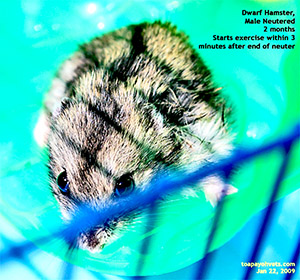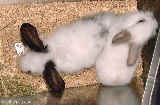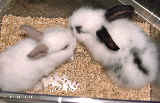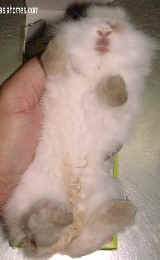 "My
rabbit has smelly stools for the past two days," said Ms Anderson. "What
caused its diarrhoea?"
"My
rabbit has smelly stools for the past two days," said Ms Anderson. "What
caused its diarrhoea?" I picked up the 30-day-old white dwarf rabbit and there were faecal stains on the anal area spreading to the lower part of the body, between the hind legs.
"It just would not eat the dry pellet feed sold to me by the pet dealer," said Mr Anderson. "It just ate the green hay all the time. How do I get it to eat the pellets?"
The white dwarf looked healthy and was more active and very inquisitive than its black and white play mate. It was purchased seven days ago.
"What could cause diarrhoea in one rabbit and not in the other?" Both had the same feeding management and the same corn-based litter and both shared one water bottle. Mr Anderson had bought the green rabbit hay along. The white rabbit was not interested in the hay although the black and white nibbled a bit.
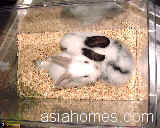 It
was hard to diagnose what caused diarrhoea in this hyperactive
dwarf rabbit.
It
was hard to diagnose what caused diarrhoea in this hyperactive
dwarf rabbit."Did he eat telephone wires, newspaper, the corn litter or other things?" I asked.
"No," Mr Anderson replied. "He ate only the hay and pellets provided by the pet dealer and he was all right when I bought him. In fact, he does not even look sick."
It was not possible to take the rectal temperature of this baby rabbit as it was so small. Observations indicated it was an active rabbit. "Did it eat the pelleted feed while it was at the pet shop?" I asked Mr Anderson.
"I did not notice what type of feed it was having," replied Mr Anderson. He was a first-time rabbit pet owner.
A change of feed is a main cause of diarrhoea in a newly acquired baby rabbit. What was the change in the management of the dwarf rabbit? It would not eat the pelleted feed. Most likely, it was too young and not used to it. The hay from the pet shop looked like it was of a good quality. Would eating hay cause diarrhoea? When did the rabbit start eating hay?
"What else did the rabbit eat?" I asked.
"Beats me!" replied Mr Anderson. There were no stool samples to examine.
There was a green box of "honey stick for rabbits" to improve their appetite. It looked like an ice-cream stick glued with seeds.
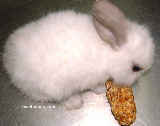 I
offered the honey stick to the white cotton ball dwarf rabbit.
It just would not stop eating it. "He ate one whole stick
yesterday morning" Mr Anderson commented.
I
offered the honey stick to the white cotton ball dwarf rabbit.
It just would not stop eating it. "He ate one whole stick
yesterday morning" Mr Anderson commented. "Was the rabbit passing smelly stools before you gave it the honey stick?" I asked.
"No," Mr Anderson replied. This was the clue to its smelly diarrhoea. Over-eating of a new diet would upset the bacteria in the rabbit's gut and lead to wet stools.
Mr Anderson was asked to isolate this rabbit and give it plenty of water, hay and some pelleted feed for the next 7 days.
A 30-day-old rabbit would be weaned off its mother's milk recently. Young rabbits may take solid food after 21 days. It was best to introduce new feed like the honey stick gradually and definitely not a stick a day as the honey stick is more like a dessert rather than the main course. Definitely, the bunny would prefer the sweet stick to the pelleted feed and that was the reason it was not eating the dry feed but it would not be eating a balanced diet.
"This rabbit looks healthy," said Mr Anderson. "Maybe it does not need a vet."
"Diarrhoea in baby rabbit is always a serious problem. It may get worse and die of dehydration in the next few days." I gave the rabbit dextrose saline and antibiotics by the subcutaneous route and the owner took the rabbit home to nurse it.
 TOA
PAYOH VETS
TOA
PAYOH VETS